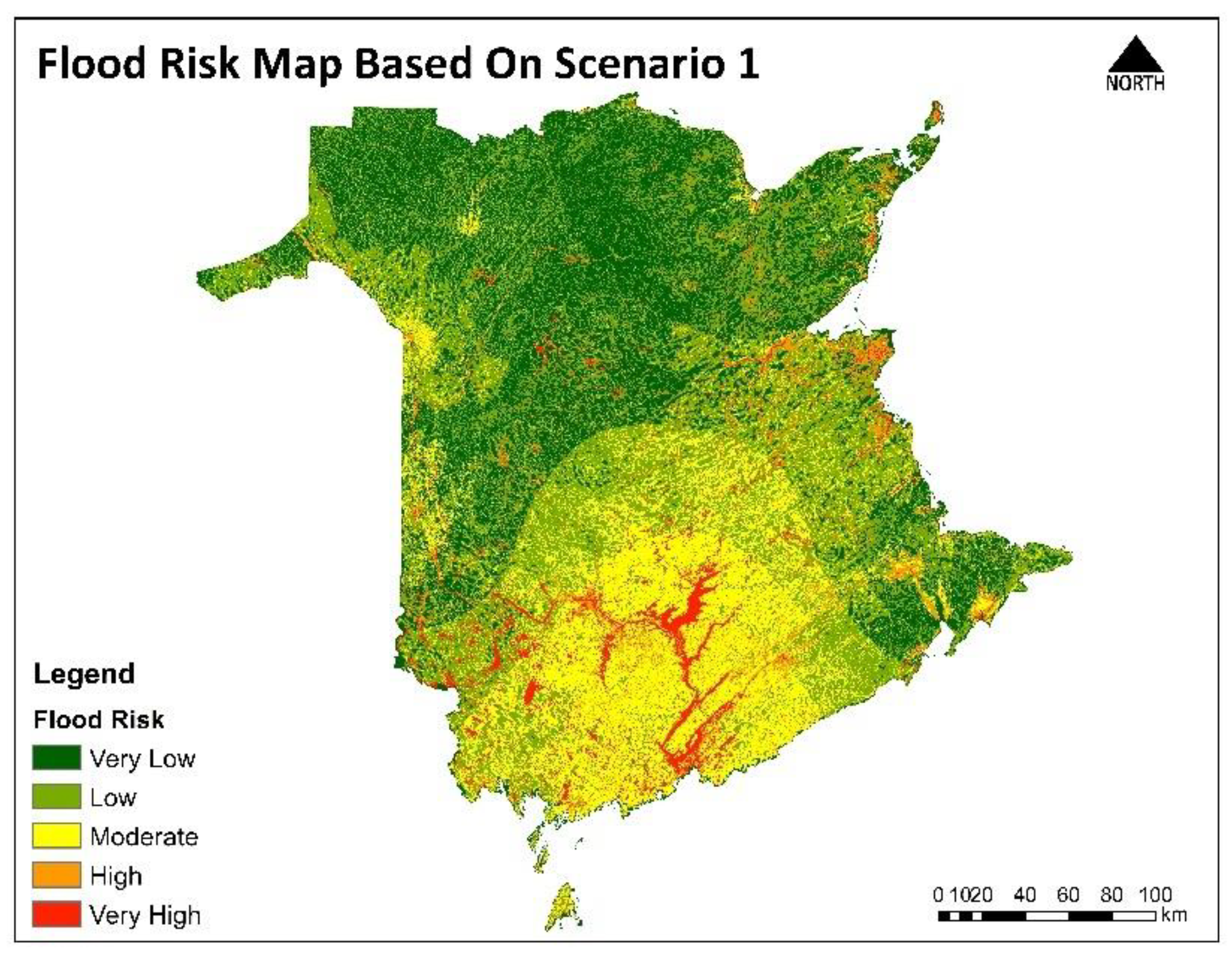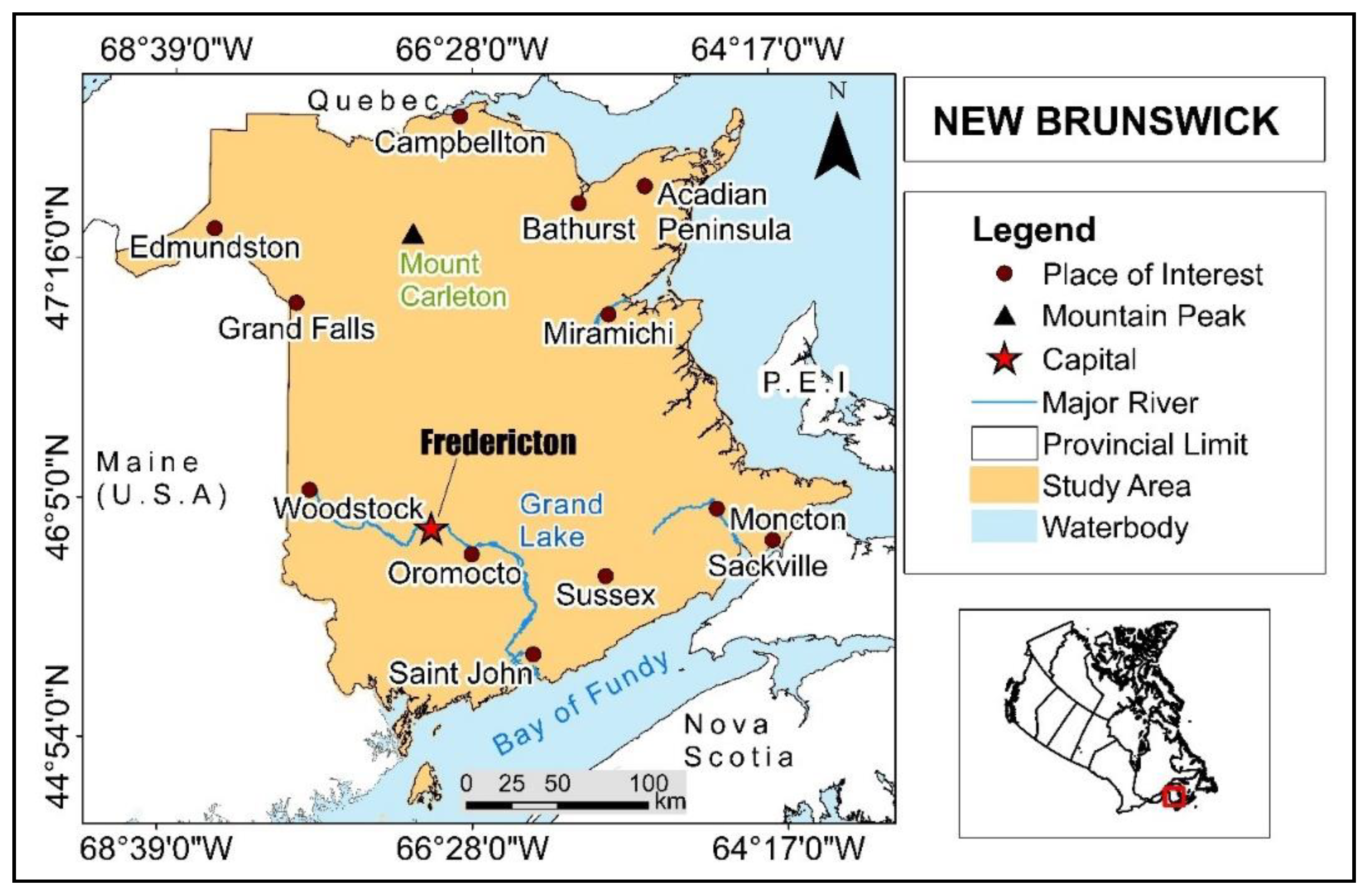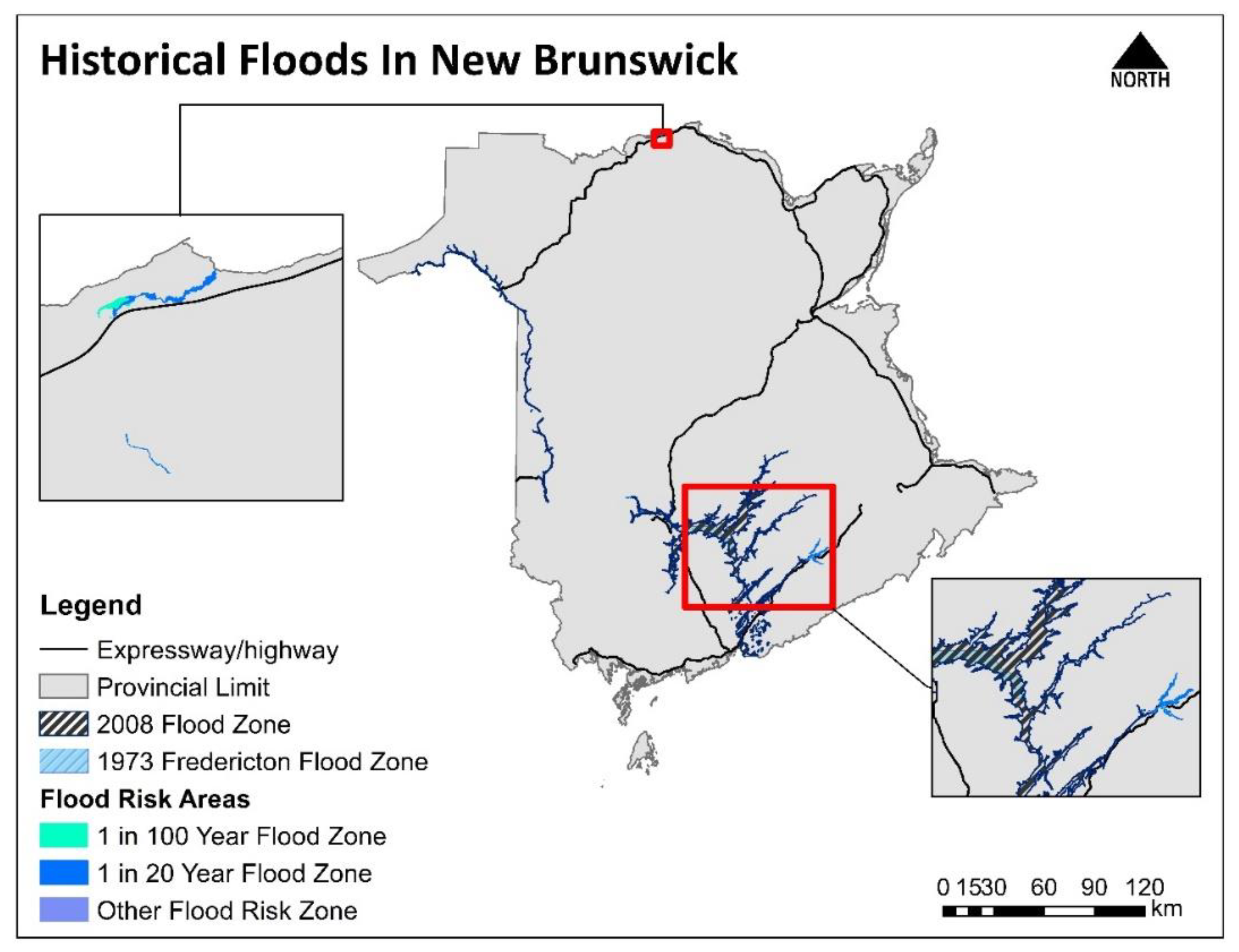1. Introduction
In New Brunswick, floods are the most destructive type of hazard, with costs estimated at
$245 million Canadian dollars for the period 1913–2014, although damage estimates have not been completed for many flood events [
1]. These events have led to the destruction of properties, infrastructure and ecosystems. Infrastructural assets (roads, railways, ports, airports, electricity grids, Information and Communications Technology (ICT)) are important to our society, as they provide the means through which economic activity, connectivity and transportation are facilitated [
2]. The disruption of movement along roads is recurrent in the province, and causes the displacement of people, goods and services. For instance, the flood event between 13 December and 14 December 2010, resulted in the closure of about 120 roads in the southern and western section of the province [
1]. Flooding also caused the closure of the Trans-Canada Highway between Fredericton and Moncton for many days, especially during the May 2018 flood [
3].
Prioritizing flood-prone areas is therefore important in identifying regions that require detailed mapping using hydrodynamic models. In fact, flood hazard identification and priority setting is one of the steps in the Federal Flood Mapping Guidelines Series document that is being developed by Natural Resources Canada (NRCan) and Public Safety Canada [
4], as shown in
Figure 1. A methodology is therefore needed to determine where to commence flood mapping based on the prioritization of flood-prone areas. However, this component of the guideline has not been completed. As a result, flood risk practitioners in Canada will have to develop their own methodology based on the availability of data and the scale of the analysis.
Various studies on the prioritization of flood-prone areas have been conducted in Canada. In Halifax, the capital of Nova Scotia, a flood risk assessment was conducted after the prioritization of flood-prone areas [
5]. The high-risk areas were obtained through literature reviews, workshops and stakeholder consultations, along with the use of the Risk Assessment Information Template (RAIT), which was developed by Public Safety Canada, where weights were applied to each criterion in the form of a matrix. Afterwards, the sites ranked (numerically) with the highest priority were selected for a detailed assessment.
In the Regional District of Central Kootenay in British Columbia, a multi-hazard assessment was carried out to identify and prioritize floods and steep creek hazards that might threaten physical assets [
6]. This resulted in a geohazard and consequence rating generated based on an exposure and geohazard assessment with the use of weights to produce high-risk areas.
Similarly, in Edmonton, Alberta, a multi-criteria analysis by sub-basins was conducted in order to rank mitigation options for flood risk management based on three levels of impact: moderate, major, and extreme [
7]. The methodology incorporated the use of stakeholder participation, where public opinions were collected via surveys, community meetings, and in a focus group setting. The preferences were ranked according to the most and least important.
As this relates to the prioritization of flood risk in other jurisdictions, a wide variety of approaches have been used. For example, a qualitative flood risk prioritization study was conducted in a rural area in Columbia at the watershed level [
8]. The study utilized a geomorphic approach to delineate the floodplain, which was combined with vulnerability indicators to produce an index that indicate watersheds that were ranked from low to high priority.
Prioritizing flood-prone areas was also conducted in the United Kingdom based on exposure analysis [
2]. The methodology shows how to locate and make comparisons between transportation networks within flood-prone areas in order to prioritize mitigation options and increase the ability to cope with floods. Specifically, the authors assessed the impact of these assets on customer interruption. Additionally, a spatial prioritization of flood-prone areas at the catchment level in Newcastle was conducted based on the following priority criteria: contribution to total flood extent, maximum flood depths, flooded green spaces and roads and the likelihood of flood exposure [
9]. For this, the physical impact of floods, land use and exposure to settlements and road infrastructure were considered.
In Bangkok, Thailand, the quick scan methodology was used to assess the vulnerability and mitigation of critical infrastructure from floods in urban areas in order to identify and rank critical infrastructural assets and building clusters in flood-prone areas in three communities [
10]. This was achieved through the use of stakeholder engagement in workshops and interviews to gain input and feedback. The results demonstrated that secondary roads, markets, shopping centers, residential water supply and sanitation were ranked the highest.
As indicated, different approaches were used in the prioritization of flood risk. While some used stakeholder engagement and quantitative analysis, others applied weights to variables that represented flood hazard, vulnerability or exposure. Currently, there is no specific standard that is available; hence, the methodology used in flood priority studies depends on many factors. Furthermore, most of the studies presented, except [
8] and [
6], were within urban areas, and might not be applicable at the provincial scale and in rural areas.
Flood assessment can be conducted at various scales [
11]: the supra-national (global), macro(national), meso (province, watershed or large city) and micro levels (town or river). Macro-level analysis can include the use of a single model or the aggregation of analysis conducted at the meso-scale; however, this can lead to inconsistency. At the meso-scale, the use of a standard return period can be misleading for large-scale analysis, resulting in the overestimation of flood risk. To overcome this, continuous rainfall runoff and hydrodynamic modelling can be used, but long computational times and the unavailability of data act as hindrances to hydrodynamic modelling at the meso-scale. Therefore, simple methods are normally used to circumvent the aforementioned issues [
11]. Hence, the methodology used in flood research depends on the scale of analysis and the availability of data.
In this study, we present two approaches to prioritize flood-prone areas at the meso-scale in New Brunswick, a rural province in Canada. The first method involves a spatial multi-criteria evaluation technique (SMCE) [
12]. The second approach involves the use of a geomorphic procedure to delineate floodplains based on a 20-year return period and the assessment of exposed assets [
13]. Specifically, the prioritization based on the exposure analysis was conducted by intersecting the flood-prone areas with roads that were ranked similar to the method proposed in France for analyzing potential flood damage to transportation networks at the meso-scale [
14]. The United Nations Platform for Space-based Information for Disaster Management and Emergency Response (UN-SPIDER) also suggests a similar approach for the damage assessment of assets after flood events [
15].
As indicated by the World Bank [
16], multi-criteria assessment is one of the methods that can be used for prioritization, especially in data-scarce environments. However, this approach might be challenging due to the difference in temporal and spatial scales of the datasets, which are available [
17] and can have some amount of bias when weights are applied. Nonetheless, there has been an increase in the utilization of this technique for prioritization [
18]. Furthermore, multi-criteria analysis is useful for analyzing flood hazard above the micro-scale in order to identify priority areas so that detailed analysis using hydrodynamic models can be conducted [
19].
Even though the impact of infrastructural assets during floods can be severe, there a is paucity of studies that assess their impacts [
2]. Moreover, most of the studies that have been undertaken might not be applicable in certain environments due to the complexity of the methods, which sometimes lead to unreliable results, particularly in data-sparse regions [
20] such as New Brunswick. As a result, the use of a simple technique is sometimes necessary for the identification and ranking of infrastructural assets [
10].
4. Discussion
The results obtained from the multi-criteria analysis indicate the complexity involved when prioritizing flood-prone areas at the provincial scale. It is evident that both scenarios 1 and 2 have similarities in terms of the predominance of high flood-prone areas in the south-central part of the province, which is where the capital (Fredericton) and a major city (Saint John) are located. However, the ranking of flood-prone areas changed with each scenario. One possible reason could be due to the fact that scenarios 1 and 2 incorporated rainfall as the main variable that influence floods. In contrast, the floodplain was assigned the higher weight in scenario 3 and rainfall was not included. These very high flood risk areas, observed in dark red, were assigned the highest rainfall values, which implies that the flood hazard map with rainfall had a stronger influence on the results that were generated. Furthermore, HAND is based on height of the drainage network, while TWI demonstrates areas that are likely to become saturated. On the other hand, the floodplain is limited to the flat areas close to river channels that can be flooded.
The areas in the south-central region of the maps (
Figure 9) with high risk are in line with flood risk zones that have been mapped in New Brunswick [
33]. As demonstrated, many areas are unmapped, even though floods have been reported elsewhere. This provides justification for the use of SMCE in order to identify flood-prone areas that are needed for mapping purposes.
In the exposure analysis, the smaller roads were ranked lower, but the impact of the damage can be enormous, especially in rural areas when repairs are required for a small amount of people. To gain an overview of the impact of roads during floods in the province, the event between 14 April and 20 April 2014, is highlighted. This event caused damage to about 715 homes and commercial entities and the transportation network, which resulted in the closure of numerous roads [
1]. The total damage from this event was estimated at
$16 million Canadian dollars [
1]. Moncton, for example, recorded about six road closures on 11 April 2014, while three roads were closed on 16 April 2014. In Sussex and Sussex Corner, about 1450 people had to be evacuated and numerous roads were damaged. Road closure was also reported in Miramichi, Fredericton, Saint John, Sackville and areas connected with the Trans-Canada Highway [
1].
Another catastrophic flood includes the 2018 event that led to the closure of about 81 roads, including the Trans-Canada Highway, mostly along the Saint John River from Fredericton to Saint John [
34]. Additionally, the flood between 15 April and 16 April 1994, which affected the Cains River Road in Upper Blackville, caused disruption to movement [
1]. The number of roads affected shows the vulnerability of transportation networks during flood events in the province, which can affect the movement of goods, services and evacuation exercise during an emergency.
As demonstrated, it is difficult to use one standard approach to prioritize flood-prone areas, as the ranking can change depending on the criteria that are used. Similar to our study, the flood risk prioritization analysis that was conducted in Columbia [
8] revealed changes in the level of vulnerability when a sensitivity analysis was conducted. Specifically, the results obtained were sensitive to the criteria used, as the vulnerability changed from low to medium and medium to high in some instances.
The challenge is, therefore, how to aggregate the risk, as the same dissemination areas in our study are not always ranked first in all the scenarios. This shows the difficulty involved in conducting flood risk prioritization at the meso-scale and the importance of using expert knowledge and stakeholder engagement. While expert knowledge was utilized, the use of stakeholders was a major limitation in our study due to COVID-19. The question is, therefore, on which basis should we evaluate and prioritize areas that are prone to flooding? Certainly, the level of risk will change depending on the methodology, criteria and scale of analysis as demonstrated. Hence, a standard methodology might not be feasible and should be developed based on the objective of the study.
It must be noted that the results obtained in this study are based on a methodology that was feasible, given the data availability and the objective. Numerous approaches exist, but the scale of our analysis presented challenges for replicability. For instance, the following author [
35] illustrates the scales at which hazard assessments are normally conducted (
Table 9). As indicated, the provincial level normally covers 1000–10,000 km
2. However, New Brunswick has an area of about 71,388 km
2, which is more in line with studies that are generally conducted at the national level (area between 30–600 thousand km
2), as shown in
Table 9.
In some research, one-dimensional models are used to approximate peak flow at the provincial scale [
35]. Even though New Brunswick has many rivers, most of the streams are ungauged, which makes the use of such models challenging for use at the meso-scale. Moreover, the incorporation of building information such as height, type and use can be incorporated in flood assessment at the provincial scale with results generated from the models [
35]. However, in New Brunswick detailed building information is not yet available for every location. This illustrates the challenges, as it relates to conducting flood hazard and risk assessment at the provincial scale, as the methodologies used in most studies are not always applicable in other locations. Therefore, we tested two approaches that were feasible based on the data availability, computational time and scale of the analysis.
Our approach falls within the context of a qualitative technique, which is normally useful for the identification of hazards and risks as a screening tool, especially at the provincial scale in data-sparse areas [
35]. Since the approach used in this study was for screening purposes, other studies should be conducted based on a quantitative approach at other scales in order to obtain the direct and indirect losses for elements at risk (assets).
5. Conclusions
This study prioritized flood-prone areas at the provincial scale based on a qualitative approach in order to identify areas that will require detailed flood mapping using hydrodynamic models. The results from the multi-criteria and exposure analyses revealed some important aspects, as they relate to data, methodology, scale and decision-making, where risk and the prioritization of flood-prone areas are concerned.
Despite the complexity involved in flood assessment at the provincial scale, some patterns are evident. From the multi-criteria analysis, dissemination areas with high to very high flood-prone areas are located mostly in the south-central region of the province, while the lowest-ranked flood-prone areas are concentrated in the north central section in Scenarios 1 and 2 of the SMCE.
Similarly, transportation networks that have a high to very high risk of being damaged are located within the south-central section of the province, although some can be found along the coast and the north-west.
The results also indicate how prioritization changes based on the criteria used, which suggest that a standard methodology might not be applicable when ranking flood-prone areas. Nonetheless, this study can be applied to other locations where data paucity is a challenge.


































